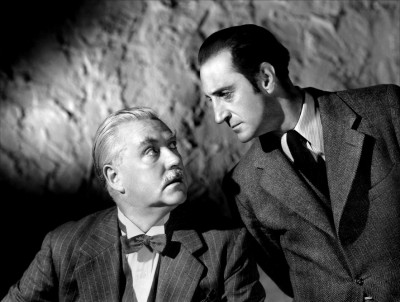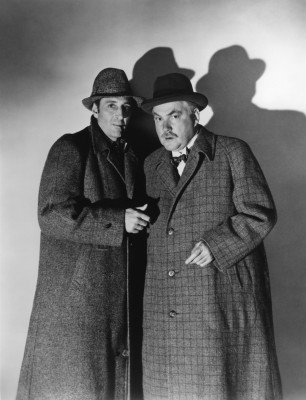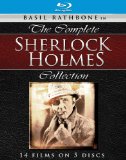| Reviews & Columns |
|
Reviews DVD TV on DVD Blu-ray 4K UHD International DVDs In Theaters Reviews by Studio Video Games Features Collector Series DVDs Easter Egg Database Interviews DVD Talk Radio Feature Articles Columns Anime Talk DVD Savant Horror DVDs The M.O.D. Squad Art House HD Talk Silent DVD
|
DVD Talk Forum |
|
|
| Resources |
|
DVD Price Search Customer Service #'s RCE Info Links |
|
Columns
|
|
|
Complete Sherlock Holmes Collection (the 14-film Basil Rathbone-Nigel Bruce series), The
The twelve Basil Rathbone-Nigel Bruce Sherlock Holmes movies made at Universal were first released to DVD by MPI in three volumes with an SRP of $69.98 each. The following year MPI released the two earlier Rathbone-Bruce Holmes films (made at Fox) for $19.98 apiece; meaning the combined retail price of all 14 films back in 2004 was a wallet-busting $249.90. This new Blu-ray set, with all 14 films in high-definition, plus a few new extra features retails for about half that, $129.98, though most on-line dealers are selling it for $80 or less. That's an incredible deal if you don't already own the DVDs.
For the rest of us, it really boils down to a combination of personal taste, affection for the series, the limitations of the surviving film elements, and the size monitor you'll be watching these films on. On smaller monitors the difference will be almost imperceptible, but on big screen TVs there's a noticeable bump in quality that improves the sharpness and more detail is visible. Tweeds and other costuming particularly stand out, while shadows have inkier blacks, boosting the atmosphere considerably. However, this is inconsistent due to the lack of pristine elements and even at its best The Complete Sherlock Holmes only rarely approaches the extreme clarity of better-preserved titles like Warner Home Video's gorgeous Casablanca, made about the same time.
On the other hand, if you're as fond of these movies as I am, and if that little extra bit of added high-def clarity is worth the cost....
The Rathbone-Bruce Sherlock Holmes films began in 1939 at 20th Century-Fox, with The Hound of the Baskervilles. Sir Arthur Conan Doyle's immortal characters had been adapted for the movies at least as early as Sherlock Holmes Baffled in 1900, but the film and Rathbone's performance in particular struck a chord with audiences. A follow-up, The Adventures of Sherlock Holmes, loosely based on William Gillette's 1899 play, was filmed later that same year, but Fox didn't pursue the series any further.
The reasons for this are not definitively known. Fox had a cash cow in various mystery series, including Charlie Chan, Mr. Moto, and Michael Shayne, and you'd think a Sherlock Holmes film series would've been right up their blood-spattered alley. Some have pointed to Hound's poor critical reception in Great Britain, but that seems a dubious reason so long as the films made money. I suspect Fox was more concerned about the higher cost of a Holmes series relative to their other mystery films, all B-pictures. Period films, with their unique costumes, props, and sets, generally cost more to make than stories with contemporary settings, and Rathbone was a bigger and costlier star than, say, Sidney Toler as Charlie Chan. And Nigel Bruce undoubtedly would've been a whole lot more expensive than the various Asian actors playing Chan's sons.
In any case, the series ended almost before it got started, but The New Adventures of Sherlock Holmes, a radio series starring Rathbone and Bruce, was an enormous hit. I suspect much of its success had to do with timing: the series debuted on October 2, 1939 - a month and a day after the start of World War II in Europe and almost exactly a year before The Blitz, when the very survival of Great Britain was anything but assured and America rallied, however indirectly, to her aid. The radio series, which like the Fox films retained its Victorian setting - albeit with prologues featuring an elderly Dr. Watson now retired to California bungalow! - ended in 1946, the same year as the Universal film series.
The success of the radio series prompted Universal to license screen rights plus use of 21 of Arthur Conan Doyle original stories (barely touched) in early 1942, for a period of seven years and at a cost of $300,000. (Joining Rathbone and Bruce from the Fox films, through radio and the Universal series was Mary Gordon, charming as Holmes's long-suffering housekeeper Mrs. Hudson.) Unlike Fox, Universal made the radical decision to set their Holmes series in present-day London rather than late-Victorian England, in which his adventures are typically set.
In fact the impact of this decision is slight. After all, Conan Doyle's* final Holmes story was published just 15 years earlier, in 1927. Horse-drawn Hansom cabs were still in use in London as late as 1947, though by 1942 automobiles greatly outnumbered such antiquated means of transportation. Still, Britain hadn't changed all that much since the turn of the century and anyway much of the series would be shot on Universal's timeless backlot streets.
A more eyebrow-raising departure was that, in Universal's first four entries anyway - Sherlock Holmes and the Voice of Terror (1942), Sherlock Holmes and the Secret Weapon, Sherlock Holmes in Washington, and Sherlock Holmes Faces Death (all 1943) - Sherlock Holmes would match wits with various Nazi agents, though this too was standard operating procedure in Hollywood circa 1942. If Tarzan, the Three Stooges, and Donald Duck were battling Nazis alongside John Wayne, Errol Flynn, and Humphrey Bogart, why not Sherlock Holmes?
Aficionados generally prefer the Holmes films that immediately followed: Sherlock Holmes Faces Death (1943), The Spider Woman, The Scarlet Claw, and The Pearl of Death (all 1944). These movies for the most part dropped the wartime intrigue in favor of period-flavored thrills often intermingled with horror genre elements. But I'd argue the first two Universal entries, Voice of Terror and Secret Weapon, more than compensate with their extremely impressive noirish cinematography and lighting. That said, Sherlock Holmes in Washington takes too many liberties, somewhat ironically when you think of it: the two Fox films show virtually no signs of having been influenced by the company's Charlie Chan films, yet Sherlock Holmes in Washington suggests Universal may have briefly toyed with the idea of a globetrotting Holmes like Chan (i.e., Charlie Chan in London, ...in Paris, ...in Egypt, etc.). Most of the films from this period conclude with a little epilogue of Rathbone extolling the virtues of England, its King or Prime Minister in a stirring little preamble to a more direct pitch to the movie-going audience to buy war bonds, "on sale in this theater." These war bond ads at the tail have been restored.
The biggest complaint Holmes purists generally have with the series is Nigel Bruce's buffoonish Dr. Watson, who in the original stories was a highly capable and trusted companion to Holmes. (My vote for the best Watson goes to David Burke, who played him on the first series only of the Jeremy Brett TV series.) In the Rathbone-Holmes movies (and solidified in the Fox films and on radio, long before the series went to Universal), Bruce provides the comedy relief, rather like Charlie Chan's overly-enthusiastic amateur detective sons. If Rathbone's Holmes was always two steps ahead of the movie audience, you could be sure Bruce's Watson was at least four steps behind them. He frequently fouled things up for Holmes and only rarely comes to his rescue, while Rathbone's Holmes in most of the films treats Watson in a very condescending manner, at times as if talking to a child. (Though as reader Sergei Hasenecz points out, Holmes always defers to Watson regarding medical matters.)
Yet 1940s audiences loved Bruce's characterization, and just as Rathbone came to be regarded as a gold standard for Holmes until Jeremy Brett's game-changing portrayals in the first few series he did for Britain's Granada Television, Bruce was the Watson several generations knew first and best.** Oddly, few complain about Dennis Hoey's unrefined, bumbling Inspector Lestrade, who appears in about half the Universal films. Hoey's a delight even if he's physically almost the opposite of the literary character, who's lean and ferret-like (Hoey is tall, coarse, and fleshy), and more Agatha Christie's Inspector Japp than the Conan Doyle Lestrade. And none of that matters in the slightest. (Nor does the fact that his named is pronounced "La-Strodd" in this series but "La-Strayed" in most other adaptations.)
As was often the case with film series cranked out at a rate of three or more features per year, the same casts and crews were utilized again and again. Roy William Neill directed all of the later ones, and he's generally credited with steering it back toward a late-Victorian/early-Edwardian atmosphere. On the other hand, it's also true that by the time Neill took over the reins audiences had grown weary of the incessant wartime propaganda, and in response the studios weren't lacquering it on as thickly in 1944 and '45 as they had in '42 and '43.
The movies certainly benefited from their British-dominated casts, who surely must have bonded making these movies together while worrying about friends and family back home in England. Among the more familiar faces, some British, some not: Paul Cavanaugh, Ian Wolfe, Gerald Hamer, Frederick Worlock, Holmes Herbert, Harry Cording, Gavin Muir, and Cyril Delevanti, among others. The incredibly beautiful British actress (though Chile-born) Evelyn Ankers appears in two of the films.
Ankers was equally known for her horror movie appearances, and as the war was winding down, the series inched closer toward full-blown horror itself. This was most obvious in films like The Scarlet Claw and The Pearl of Death, the latter featuring cult actor and acromegaly victim Rondo Hatton as "The Creeper," a "monster" Universal rather tastelessly attempted to build into a franchise over several films. George Zucco, Lionel Atwill, and Henry Daniell, also known for their fright films, each took a stab at Holmes's arch-nemesis, Professor Moriarty.
The last titles - The House of Fear, The Woman in Green, Pursuit to Algiers (all 1945), Terror by Night, and Dressed to Kill (both 1946) - show the series in slow but steady creative and budgetary decline, though I consider Terror by Night to be one of the all-time best in spite (or perhaps partly because) of its claustrophobic train-car setting. (It also does something extremely rare for a Hollywood mystery series entry of the 1930s or '40s. It plays fair with its audience. Watch Rathbone make a clever switch with a prop right in front of the camera lens that almost nobody in the audience ever notices.)
Rathbone, feeling horribly typecast, walk away from Sherlock Holmes in 1946 and the series ended, though given Neill's untimely death and a change of management and policies at Universal that same year, it's doubtful the series would have lasted more than a few additional entries anyway.
Video & Audio
The Basil Rathbone-Nigel Bruce Sherlock Holmes movies are controlled neither by Fox nor Universal. As was common for the period, after several years rights apparently reverted to the Conan Doyle estate, which subsequently re-licensed the films to others. (Two other notable examples of this are Universal's Flash Gordon serials and Columbia's Blondie film series, both of which eventually reverted back to King Features Syndicate.) In the process, four of the Universal films (Sherlock Holmes and the Secret Weapon, The Woman in Green, Terror by Night, and Dressed to Kill) lapsed into public domain and have been sold by innumerable bottom-feeder labels. In recent years, the films have been in the hands of King World Productions, which since MPI's DVD releases has been absorbed by CBS Television.
The original film elements for Hound of the Baskervilles and The Adventures of Sherlock Holmes may have been stored apart from the Universal titles, possibly even in Fox's vaults. Hound especially is in superb condition, with Adventures just a notch below that.
The Universal movies were in much worse shape, and survive as well as they do thanks entirely to the Herculean efforts of the UCLA Films and Television Archive and private donations, prominently including Playboy publisher Hugh Hefner. An introduction by Robert Gitt on disc one summarizes the many obstacles they faced. In the cases of Voice of Terror, Washington, Pearl of Death, and Woman in Green, for instance, the original camera negative survived and the subsequent video transfers are excellent. Other films were more challenging. The original camera negative for The Scarlet Claw is believed lost, and there wasn't even a good master positive from which to work, while Pursuit to Algiers' surviving film elements were besieged with vinegar syndrome (a chemical degradation) and transferred in the nick of time.
At some point, either when they were theatrically reissued or perhaps when first syndicated to television, all references to Universal during the opening and closing titles were crudely amputated from the original film elements, so UCLA worked hard to reinstate the original credits, though in the case of Dressed to Kill they were forced to utilize a really battered 16mm source and a few seconds at the end of the film remains missing.
It also appears that even within the films themselves what survives varies. The entire first reel of The House of Fear looks very weak, like a blah standard-def DVD, then about 9 1/2 minutes in suddenly pops into crystal clarity. This happens on several films.
In the final analysis, the worst looking entries (which also tend to have weaker audio) look very good at least some of the time while the best ones are real eye-openers, especially for fans so familiar with the series, and though flawed, seeing the original opening and end titles, even drawn from inferior film sources, is a real treat. The mono audio (English only) is acceptable throughout and optional English subtitles are available.
Amazingly, all 14 movies are contained in a single standard Blu-ray case on five discs, taking up the same amount of shelf space as the Hound of the Baskervilles DVD did all by itself. Since many of the films run 60-70 minutes, there aren't any real compression issues; the combined running time is 16 hours, 14 minutes. The discs are region "A" encoded.
Extra Features
Sadly not included with the set are the late Richard Valley's helpful liner notes which accompanied the DVD versions. Those rigorously yet affectionately compared the particulars of Conan Doyle's characters and stories to their movie counterparts. They're sorely missed.
However, all of the other extra features from the DVDs appear to have been retained, including six commentaries (some of which feature Valley) and there's one including (now 96-year-old) actress Patricia Morison (on Dressed to Kill) that for some reason was left off the original DVD release. In standard definition are some incredibly dog-eared trailers that only make these restorations look all the more impressive, and some archival film footage of Conan Doyle himself.
Parting Thoughts
If you've never seen the Basil Rathbone-Nigel Bruce Sherlock Holmes films before, unhesitatingly I urge you to rush out and buy this Blu-ray set. It's a real bargain for what you get and a DVD Talk Collector Series title. But to upgrade or not to upgrade is really a matter of personal taste. If that little but measurable-to-the-naked-eye high-def boost is worth buying these movies all over again because, well, they're just so wonderful, by all means do so. But you'll also be forgiven if you decide to stick with your perfectly fine restored DVDs.
* Conan Doyle is the widely accepted but by no means definitive reading of the author's surname. Apparently simply "Doyle" is also correct.
** I first discovered the Rathbone-Bruce series in a somewhat unconventional way, seeing most of them for the first time via Super-8 sound prints in the 1970s, part of a massive collection of 16mm and Super-8 titles one could check out just like a book from the Henry Ford Centennial Library in Dearborn, Michigan. Gone are the days.
Stuart Galbraith IV's audio commentary for AnimEigo's Tora-san, a DVD boxed set, is on sale now.
|
| Popular Reviews |
| Sponsored Links |
|
|
| Sponsored Links |
|
|
| Release List | Reviews | Shop | Newsletter | Forum | DVD Giveaways | Blu-Ray | Advertise |
|
Copyright 2024 DVDTalk.com All Rights Reserved. Legal Info, Privacy Policy, Terms of Use,
Manage Preferences,
Your Privacy Choices | |||||||














